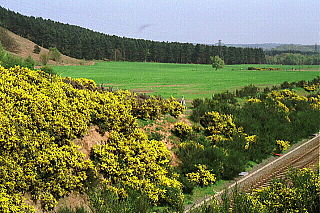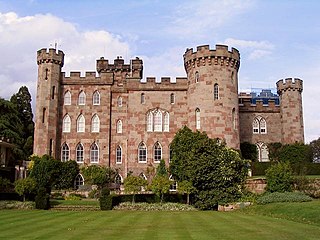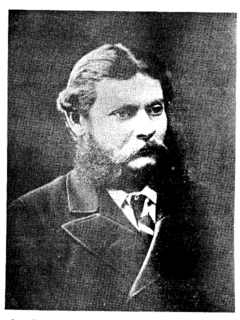
Lyme Park is a large estate located south of Disley, Cheshire. The estate is managed by the National Trust and consists of a mansion house surrounded by formal gardens, in a deer park in the Peak District National Park. The house is the largest in Cheshire, and is recorded in the National Heritage List for England as a designated Grade I listed building.

A listed building, or listed structure, is one that has been placed on one of the four statutory lists maintained by Historic England in England, Historic Environment Scotland in Scotland, Cadw in Wales, and the Northern Ireland Environment Agency in Northern Ireland.

Colwick is a village, civil parish, and suburb of the city of Nottingham, in the English ceremonial county of Nottinghamshire. It is situated to the east of Nottingham's city boundary, and forms the Colwick ward within the local government district of Gedling. At the time of the 2011 census, the village had a population of 2,829.

Annesley is a village and civil parish in the Ashfield district, in Nottinghamshire, England, located between Hucknall and Kirkby-in-Ashfield. According to the 2001 census the parish had a population of 1,096, increasing to 1,162 at the 2011 Census. Nearby to the west is Annesley Woodhouse. Presumably the Annesley family, now spread worldwide, originally took its name from that of the village.

Linby is a small village and civil parish in Nottinghamshire, England. The nearest town is Hucknall which is immediately to the south-west. The village grew up around the mills on the River Leen, from which Linby's name is derived. Small streams known as Linby Docks run on both sides of the main street. The population of the civil parish at the 2011 census was 232.
Viscount Chaworth, of Armagh in the County of Armagh, was a title in the Peerage of Ireland. It was created on 4 March 1628 for George Chaworth, who had earlier represented East Retford, Nottinghamshire and Arundel in the House of Commons. He was made Baron Chaworth, of Tryme in the County of Meath, at the same time, also in the Peerage of Ireland. He was High Sheriff of Nottinghamshire in 1638.

Cholmondeley Castle is a country house in the civil parish of Cholmondeley, Cheshire, England. Together with its adjacent formal gardens, it is surrounded by parkland. The site of the house has been a seat of the Cholmondeley family since the 12th century. The present house replaced a timber-framed hall nearby. It was built at the start of the 19th century for George Cholmondeley, 1st Marquess of Cholmondeley, who designed most of it himself in the form of a crenellated castle. After the death of the Marquess, the house was extended to designs by Robert Smirke to produce the building in its present form. The house is designated by English Heritage as a Grade II* listed building.

Clayton Hall is a 15th-century manor house on Ashton New Road, in Clayton, Manchester, England. It is hidden behind trees in a small park. The hall is a Grade II* listed building, the mound on which it is built is a scheduled ancient monument, and a rare example of a medieval moated site. The hall is surrounded by a moat, making an island 66 m by 74 m. Alterations were made to the hall in the 16th and 17th centuries, and it was enlarged in the 18th century.

Peover Hall is a country house in the civil parish of Peover Superior, commonly known as Over Peover, Cheshire, England. It is recorded in the National Heritage List for England as a designated Grade II* listed building.

St Andrew's Church, Langar-cum-Barnstone is a parish church in the Church of England in Langar, Nottinghamshire. It is Grade I listed as a building of outstanding architectural or historic interest.

All Saints', Granby is a Church of England parish church in Granby, Nottinghamshire, England. The building is Grade I listed by the Department for Digital, Culture, Media and Sport for outstanding architectural or historic interest.
The Sheriff of Nottinghamshire, Derbyshire and the Royal Forests is a position established by the Normans in England.

All Saints' Church, Annesley is a parish church in the Church of England in Annesley, Nottinghamshire.

Colwick Hall was an English country house in Colwick, Nottinghamshire. It is now a hotel. The building is Grade II* listed.

Hulme Hall is a house on a moated site in the parish of Allostock, Cheshire, England. It originated in the 15th century, with additions and alterations in the 17th and 19th centuries. It is now a farmhouse. The house is constructed in brown brick, and has a roof of stone-slate and Welsh slate. It is in two storeys with an attic, and has an asymmetrical plan. The northeast front is the entrance front, and has three gabled bays. The garden front is on the northwest; it has five bays, two of which are stepped back in two stages. Most of the windows are two or three-light casements. The house is recorded in the National Heritage List for England as a designated Grade II* listed building. The bridge over the moat leading to the house is also listed at Grade II*. The moated site on which the house stands is a scheduled monument. It had been the home of the Grosvenor and Shakerley families, both of whom were prominent in Cheshire.
Thornhill Hall is a ruined medieval manor house on a moated island located in Rectory Park, Thornhill, West Yorkshire, England. The ruins are listed as grade II. and the moat, with the surrounding grounds, is a scheduled monument.

Wiverton Hall is an English country house near Tithby, Nottinghamshire. By 1510 the former village of Wyverton had become impoverished and reduced to just four houses and a cottage. It was in that year completely depopulated by "emparkment", when George Chaworth enlarged his park by 254 acres. All but the Grade II* listed gatehouse of the mansion was destroyed in the English Civil War. The current house dates from 1814.

Patrick Chaworth was 3rd Viscount Chaworth of Armagh. He is also known as Patricius Chaworth.

Annesley Old Church or the Church of All Saints, Annesley Park, is a disused church in a ruinous condition which stands on a mound near to Annesley Hall, Nottinghamshire. The building remains are Grade I listed and are surrounded by a graveyard. The site is scheduled as an ancient monument.

George Chaworth Musters (1841–1879) was a British Royal Navy commander and traveller, known as the "King of Patagonia".


















